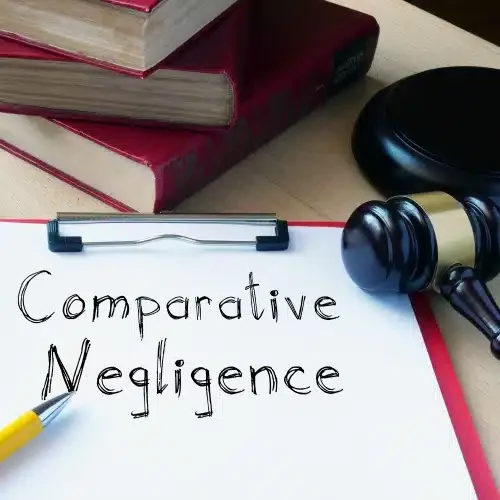
Texas 51 Percent Bar Rule
The Texas 51% Bar Rule – which is part of Texas Law – means that if you are 51% or more at fault for an accident, you cannot make a claim or get any money for your injuries or damages.
If you’ve been in a car, truck, motorbike or bicycle wreck, understanding how compensation works can be confusing. One important concept to know is comparative negligence. This principle helps decide how much each person involved in a traffic accident is responsible and how much they can be compensated.
At The Law Office Of Joel M. Vecchio, we focus on vehicle collision cases and are here to guide you through this complex process. Our experienced team ensures that you understand your rights and the steps you need to take to secure fair compensation.
In Texas, the rules for determining fault and compensation for a traffic collision are unique. This guide will explain what comparative negligence is and how it affects your ability to get compensated after a motor vehicle crash. We’ll cover how fault for a car crash is assigned, how it impacts your compensation, and what steps you can take to protect your rights.
By the end of this article, you’ll have a clearer understanding of how these rules work and what you can do to ensure you receive fair compensation for your injuries and damages, with the guidance of The Law Office Of Joel M. Vecchio.
Key Highlights
- Comparative negligence determines the degree of fault each party holds in a vehicle collision.
- Each driver’s actions are analyzed to assign a percentage of fault, impacting their compensation accordingly.
- Fault is determined by various parties including police officers, insurance companies, attorneys, and courts.
- Each party gathers and analyzes evidence, such as police reports, witness statements, and accident reconstruction expert opinions, to establish fault percentages.
- In Texas, if a person is found to be 51% or more at fault in an accident, they cannot receive any compensation for their injuries or damages.
- The 51% Bar Rule directly affects the amount of compensation one can receive. Compensation is reduced by the individual’s percentage of fault.
- If a person is 51% or more at fault, they lose the right to recover any damages, making accurate fault determination crucial.
- Selecting an experienced attorney is vital, as they can significantly influence the fault allocation and, consequently, the compensation outcome.

What is Comparative Negligence?
When a vehicle collision happens, it might not always be the fault of one person. Sometimes, both drivers share some blame. Comparative negligence is a way to figure out how much each driver is responsible for the accident. Here’s how it works:
- Percentage of Fault: Each driver’s actions are examined to see how much they contributed to the collision. For example, if driver A was speeding and driver B ran a red light, both drivers might share some fault.
- Dividing Responsibility: The fault is divided into percentages. For instance, driver A might be found 30% at fault, and driver B might be 70% at fault.
- Impact on Compensation: The amount of money each driver can claim for damages (like car repairs or medical bills) depends on their percentage of fault. If you’re found partly responsible, your compensation will be reduced by your fault percentage.
Comparative negligence helps decide how much each driver should pay or be paid based on their share of the blame for the accident.
Section 33.003. DETERMINATION OF PERCENTAGE OF RESPONSIBILITY
(a) The trier of fact, as to each cause of action asserted, shall determine the percentage of responsibility, stated in whole numbers, for the following persons with respect to each person’s causing or contributing to cause in any way the harm for which recovery of damages is sought, whether by negligent act or omission, by any defective or unreasonably dangerous product, by other conduct or activity that violates an applicable legal standard, or by any combination of these:
- Each claimant;
- Each defendant;
- Each settling person;
- Each responsible third party who has been designated under Section 33.004.
What This Means
This section explains how responsibility (fault) is determined in a lawsuit:
- Who Decides: The trier of fact (usually a jury or judge) will determine how much each person involved is responsible for the harm (like an injury from a car accident).
- Percentages: They will assign a percentage of responsibility to each person, using whole numbers (like 20%, 30%, etc.).
- Who Gets a Percentage: The percentages are assigned to everyone involved, which includes:
- The claimant (the person seeking damages).
- The defendant (the person being sued).
- Any person who settled before the trial.
- Any other responsible third parties who have been brought into the case.
This process ensures that each person’s contribution to the harm is clearly defined and quantified.
How Fault is Determined in Accidents
The determination of fault in vehicle collisions is typically made by several parties, depending on the stage of the process:
- Police Officers: At the scene of the accident, police officers investigate and often write a report that includes their assessment of fault based on the evidence they gather, such as witness statements, the position of the vehicles, and any traffic law violations.
- Insurance Companies: After an accident, each driver’s insurance company will conduct its own investigation. They review the police report, speak with their policyholders, interview witnesses, and sometimes hire accident reconstruction experts. Based on their findings, they assign a percentage of fault to each driver.
- Attorneys: If the case involves a legal dispute, personal injury attorneys representing each driver will gather evidence and build arguments to either support or refute claims of negligence. They negotiate with the insurance companies and may represent their clients in court.
- Courts: If the case goes to trial, a judge or jury will ultimately decide the percentages of fault based on the evidence presented. They listen to testimonies, examine the facts, and make a final determination.
Each of these parties plays a role in determining fault, with the goal of accurately and fairly assessing each driver’s responsibility in the collision
Here’s where Chapter 33 of the Texas Civil Practice and Remedies Code talks about proportionate responsibility. (reference)
The Texas 51% Bar Rule
The Texas 51% Bar Rule means that if you are found to be 51% or more at fault in an accident, you cannot receive any compensation for your injuries or damages. It is is a key part of the state’s comparative negligence laws. It’s a strict rule that highlights how important it is to accurately determine who is at fault in an accident.
Understanding this rule is essential if you are involved in a personal injury case in Texas. It affects how fault is determined and emphasizes the need for strong evidence and skilled legal representation. This rule makes it clear that once you pass the 51% fault mark, your chances of getting compensation disappear entirely.
Chapter 33 of the Texas Civil Practice and Remedies Code deals with “Proportionate Responsibility,” which is how the responsibility for damages is divided among those involved in a lawsuit, especially in personal injury cases. Sec. 33.001 states
…a claimant may not recover damages if his percentage of responsibility is greater than 50 percent.

Impact on Compensation
The 51% Bar Rule directly impacts how much money you can receive after an accident. If you are found to be partially at fault, your compensation is reduced by your percentage of fault. For example, if you are 30% at fault, you can only receive 70% of the total damages. Sec. 33.013 – AMOUNT OF LIABILITY states:
(a) Except as provided in Subsection (b), a liable defendant is liable to a claimant only for the percentage of the damages found by the trier of fact equal to that defendant’s percentage of responsibility with respect to the personal injury, property damage, death, or other harm for which the damages are allowed.
What does this mean? Liability Based on Responsibility: When someone is found responsible (liable) for causing harm (like an injury or property damage), they only have to pay for the portion of the damages that matches their percentage of fault.
Loss of Right to Recover Damages
If you are found to be 51% or more at fault, you lose the right to recover any damages. This rule makes it crucial to accurately determine fault, as crossing the 51% mark means you get no compensation at all. It’s a significant financial and legal turning point in your case.
Financial Responsibility for Damages
If you are at fault but less than 51%, you are still responsible for your own damages based on your percentage of fault. You might also have to pay part of the other party’s damages. This ensures that everyone pays their fair share based on their responsibility for the accident.
This rule is about fairness and accountability, making it vital to have precise fault determination in personal injury cases.
Choosing the Right Attorney
When dealing with personal injury cases in Texas, choosing the right attorney is crucial. The Texas 51% Bar Rule means that your compensation heavily depends on how fault is determined. A skilled attorney can significantly impact the outcome of your case by strategically managing fault allocation.
Legal Strategy
Applying the Texas 51% Bar Rule requires a careful legal approach. Attorneys must thoroughly analyze the incident, and examine evidence to argue for the lowest possible fault percentage for their clients. Keeping your fault below 51% is critical to maintaining eligibility for compensation.
- Photographic and Video Evidence: Images and footage capturing the accident scene, damages, and any contributing factors to the incident.
- Analyzing Physical Evidence: The examination of physical evidence from the accident scene can support claims of the other party’s negligence.
- Witness Testimonies: Statements from individuals who witnessed the accident can provide crucial third-party perspectives on the events.
- Expert Analysis: Reports from accident reconstruction experts, medical professionals, and other specialists can offer authoritative insights into the causes and effects of the accident.
- Highlighting Violations of Law: Showing that the other party violated traffic laws or safety regulations can be a powerful argument in establishing their fault.

Settlement Negotiations
In settlement negotiations and trials, fault distribution under Texas’s comparative negligence laws is crucial. Understanding how fault might be allocated in a trial helps in agreeing on fair settlements. At trial, presenting the degree of fault convincingly can significantly influence the judgment.
Dealing with Insurance Companies
Insurance companies often use the Texas 51% Bar Rule to propose reduced settlements, arguing that the claimant’s share of fault reduces their liability. This is why having strong legal representation is vital. Effective negotiation with insurers requires a deep understanding of comparative negligence and the ability to counter efforts to unfairly increase the claimant’s fault percentage.
Why Car Wreck Victims Choose The Law Office Of Joel M. Vecchio
At The Law Office Of Joel M. Vecchio, we specialize in personal injury cases involving vehicle collisions. Our experienced team is skilled in managing fault determination, evidence presentation, and negotiation to ensure the most favorable outcome for your case. We know how to deal with insurance companies that try to reduce settlements by unfairly increasing your fault percentage. Our goal is to protect your rights and secure the compensation you deserve.
Examples of Comparative Negligence
Disclaimer: The following table presents hypothetical examples of fault allocation and the resulting impact on compensation, assuming a total compensation amount of $100,000. These examples are for illustrative purposes only and do not reflect the specific circumstances or outcomes of any actual case. The allocation of fault and resulting compensation in your case will depend on the unique facts and evidence presented. Please consult with a qualified attorney for legal advice pertaining to your specific situation.
| Scenario | Description | Fault Allocation | Impact on Compensation | Compensation (from $100,000) |
|---|---|---|---|---|
| Car Accidents with Shared Fault | Driver A is speeding while Driver B runs a red light. | Driver A: 30%, Driver B: 70% | Driver A’s compensation reduced by 30%. Driver B receives no compensation due to being 70% at fault. | Driver A: $70,000, Driver B: $0 |
| Car Accidents with Equal Fault | Driver A and Driver B both run a red light and collide. | Driver A: 50%, Driver B: 50% | Driver A’s compensation reduced by 50%. Driver B’s compensation reduced by 50%. | Driver A: $50,000, Driver B: $50,000 |
| Motorcycle and Car Collision | Motorcyclist without headlights at dusk, car driver makes an illegal turn. | Motorcyclist: 40%, Car driver: 60% | Motorcyclist’s compensation reduced by 40%. Car driver receives no compensation due to being 60% at fault. | Motorcyclist: $60,000, Car driver: $0 |
| Slip and Fall Accident | Customer slips on a wet floor in a store without a warning sign, while distracted by their phone. | Store: 80%, Customer: 20% | Customer’s compensation reduced by 20%. | Customer: $80,000 |
| Dog Bite Incident | Person provokes a dog, and the dog owner fails to keep the dog on a leash. | Person: 30%, Dog owner: 70% | Person’s compensation reduced by 30%. | Person: $70,000. |
| Tractor-Trailer and Car Collision | Truck driver makes improper lane changes, while car driver is speeding. | Truck driver: 60%, Car driver: 40% | Truck driver receives no compensation due to being 60% at fault. Car driver’s compensation reduced by 40%. | Truck driver: $0, Car driver: $40,000 |
| Bicycle and Car Collision | Cyclist runs a stop sign and is hit by a car. | Cyclist: 70%, Car driver: 30% | Cyclist receives no compensation due to being 70% at fault. Car driver’s compensation reduced by 30%. | Cyclist: $0, Car driver: $70,000 |
Summary of the Texas 51% Bar Rule
The Texas 51% Bar Rule is crucial in personal injury cases, as it bars compensation if you’re found 51% or more at fault. This makes accurate fault determination essential and heavily influences legal strategies and settlements. Understanding and navigating this rule can be complex, but having skilled legal representation ensures your rights are protected and your compensation maximized.
Key Insights:
- Comparative Negligence: Texas allocates responsibility based on fault percentage, impacting your compensation.
- Impact of the 51% Bar Rule: Accurate fault determination is vital, as being over 50% at fault eliminates compensation.
- Legal and Financial Implications: This rule significantly affects legal strategies and financial outcomes in personal injury cases.
Importance of Legal Representation: Experienced attorneys gather and analyze evidence to argue for the lowest fault percentage, ensuring fair compensation. They navigate the complexities of the Texas 51% Bar Rule, providing strategic legal guidance and maximizing your potential compensation.
Contact Us for a Free Consultation
If you’ve been involved in an accident, contact The Law Office Of Joel M. Vecchio today. Our experienced team specializes in personal injury cases and can help you navigate the complexities of the Texas 51% Bar Rule. Don’t risk losing your right to fair compensation – reach out for a free consultation and let us fight for your rights.